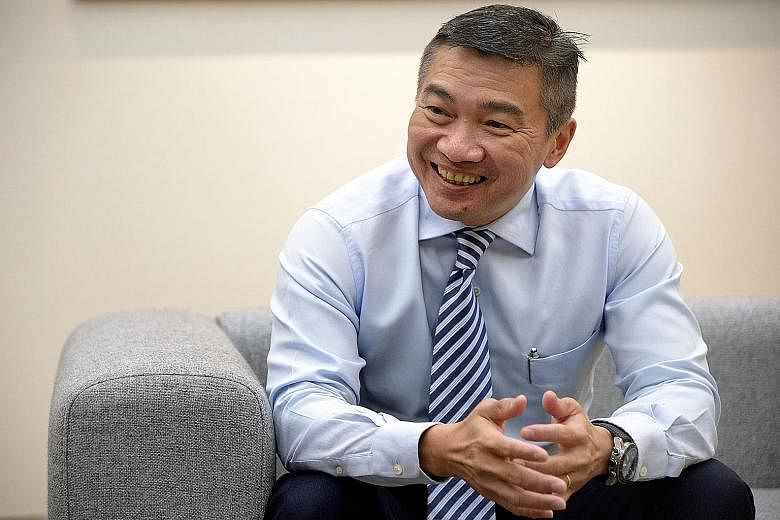There won't be a major change of course at the Singapore Exchange (SGX) under its new boss but there will be a sharper focus on the initiatives it launches to keep the business growing.
Chief executive Loh Boon Chye, who took the helm in July, believes his financial industry experience can help drive the bourse forward.
Mr Loh, 51, told The Straits Times last week: "I took up this job hoping to make a difference, but I'm not looking to rock the boat just to grab headlines. Making a difference can be about sharpening our focus, utilising my experience of a quarter of a century in the industry, and engaging our stakeholders with a viewpoint from the other side of the market."
The veteran banker has spent 26 years in the financial industry, starting as an investment officer at the Monetary Authority of Singapore and eventually becoming the head of Asia-Pacific global markets at Deutsche Bank and Bank of America Merrill Lynch.
He arrived at SGX to replace outgoing CEO Magnus Bocker amid criticism that the bourse had not done enough to spur stock market liquidity and bring in new listings.
Mr Loh stressed that while fixing the liquidity issue is an immediate challenge, his present priorities are multi-faceted. These include initiatives to build the fixed-income business while boosting the volume and diversity of its foreign exchange contracts. "The Asian bond market outside Japan is US$8 trillion (S$11.4 trillion) in size, but the secondary liquidity is fragmented, and most bonds, after their initial placement, will eventually wind up with investors and regional dealers," he said.
"So we saw a need for a market infrastructure solution. That's why we aim to launch our bond trading system early into 2016. Yes, we need equities, we need IPOs (initial public offerings), but debt financing is also a significant part of the capital market."
He also wants to see further growth in the exchange's foreign exchange contracts volume, leveraging on Singapore's position as the world's third largest forex hub. Forex futures, which is part of the derivatives business, surged 410 per cent year on year in October.
These efforts will underline SGX's overarching strategy to grow as a diverse marketplace, instead of simply a stock exchange.
"We need to profile SGX as a multi-asset, diversified platform. Securities is an important part, we need to work on it, but a strong derivatives business will reinforce the securities business," Mr Loh said.
The rapid growth of the derivatives business - which now accounts for 41 per cent of SGX's total revenue compared with securities' 25 per cent - is often cited as a sign that the bourse is shifting its focus away from the stock market.
Mr Loh rejects this notion, adding: "The whole securities vertical, which also includes listing, market data and depository services, actually accounts for around 60 per cent of our revenue. It's a big part of our business, so to say we don't care (about securities) is not true. We are multi-asset, and we need all our verticals to grow and complement each other."
He believes the bourse is already on the right track to bringing vibrancy back to its securities market, pointing to initiatives such as the smaller board-lot size introduced in January and the trading incentives granted by the Market Maker and Liquidity Provider schemes.
The results of these efforts are starting to show. SGX recorded an 11 per cent year-on-year increase in the overall retail daily average traded value for the first nine months this year.
On top of these initiatives, Mr Loh hopes to foster greater engagement in the market ecosystem.
"I have been a participant and user of the exchange. So I wish to bring that background in and have more frequent engagement with our stakeholders... The exchange was always very consultative and innovative. Many of the things have been done the right way, but my philosophy is that we can also improve and adapt."
Critics must also be mindful that the dearth of liquidity and new listings are region-wide phenomena, he noted. "It wasn't due to a lack of effort on SGX's part; market conditions also play a role.
"In the third quarter, Asia saw a 25 per cent decline in the number of deals and a 43 per cent decline in raised proceeds, according to the latest EY Global IPO Trends report."
The global growth of private capital pools is also competing with exchanges for potential fund raising opportunities. Nonetheless, Mr Loh remains cautiously optimistic about the outlook for IPOs. "We actually have a good pipeline of companies approved for listings, but they didn't happen because market conditions weren't right. When the conditions improve, I believe the companies will come back."
Meanwhile, he has begun enhancing regulatory standards. There is an ongoing review of the annual reports of mainboard-listed firms for breaches of corporate governance, and three new independent committees were formed last month to strengthen listing requirements.
But, ultimately, the SGX must not lose the balance between its dual roles, he said. "We are the market operator and we are also the regulator. Both roles are equally important for us to be successful and relevant."
From securing SGX's growth to enhancing its regulatory regime, Mr Loh sees a tough challenge ahead, but he hopes to emerge as a leader who is engaging and accountable. "I truly believe in mutual accountability. It's not just what I expect of my colleagues, it's also what they expect of me to make the team work," he said.


